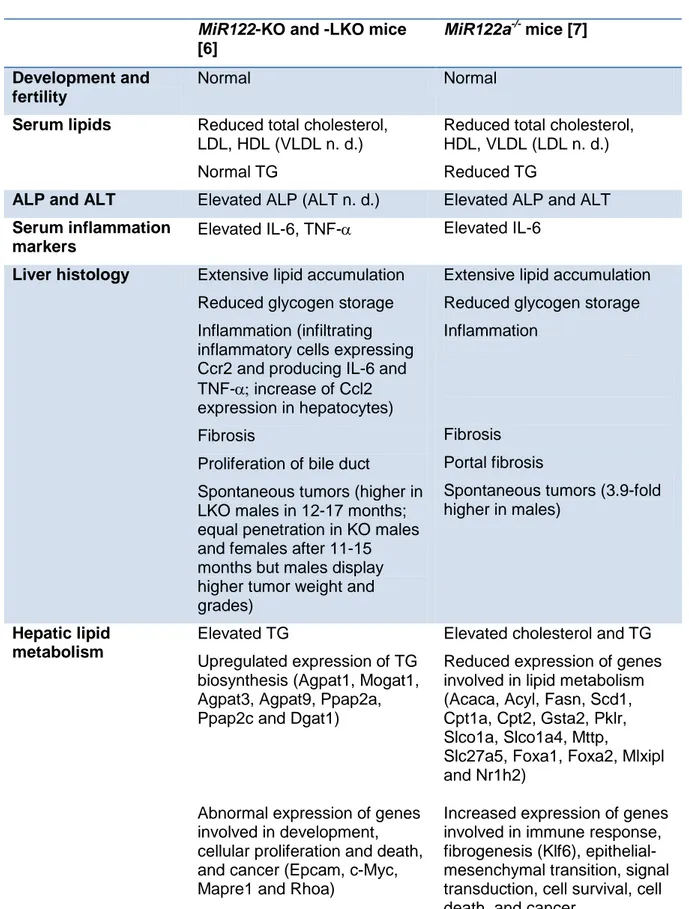HAL Id: inserm-00752918
https://www.hal.inserm.fr/inserm-00752918
Submitted on 16 Nov 2012HAL is a multi-disciplinary open access
archive for the deposit and dissemination of sci-entific research documents, whether they are pub-lished or not. The documents may come from teaching and research institutions in France or abroad, or from public or private research centers.
L’archive ouverte pluridisciplinaire HAL, est destinée au dépôt et à la diffusion de documents scientifiques de niveau recherche, publiés ou non, émanant des établissements d’enseignement et de recherche français ou étrangers, des laboratoires publics ou privés.
miR-122 acts as a tumor suppressor in
hepatocarcinogenesis in vivo.
Mirjam Zeisel, Sébastien Pfeffer, Thomas Baumert
To cite this version:
Mirjam Zeisel, Sébastien Pfeffer, Thomas Baumert. miR-122 acts as a tumor suppressor in hepatocarcinogenesis in vivo.. Journal of Hepatology, Elsevier, 2012, epub ahead of print. �10.1016/j.jhep.2012.10.010�. �inserm-00752918�
Table 1. Phenotype of miR122 knock-out mice and effect of miR122 restoration.
This table summarizes the characteristics of MiR122a-/- as well as KO and MiR122-LKO mice [6, 7]. n. d.: not determined
MiR122-KO and -LKO mice
[6]
MiR122a-/- mice [7]
Development and fertility
Normal Normal
Serum lipids Reduced total cholesterol, LDL, HDL (VLDL n. d.) Normal TG
Reduced total cholesterol, HDL, VLDL (LDL n. d.) Reduced TG
ALP and ALT Elevated ALP (ALT n. d.) Elevated ALP and ALT
Serum inflammation markers
Elevated IL-6, TNF- Elevated IL-6
Liver histology Extensive lipid accumulation Reduced glycogen storage Inflammation (infiltrating inflammatory cells expressing Ccr2 and producing IL-6 and TNF-increase of Ccl2 expression in hepatocytes) Fibrosis
Proliferation of bile duct
Spontaneous tumors (higher in LKO males in 12-17 months; equal penetration in KO males and females after 11-15 months but males display higher tumor weight and grades)
Extensive lipid accumulation Reduced glycogen storage Inflammation
Fibrosis Portal fibrosis
Spontaneous tumors (3.9-fold higher in males)
Hepatic lipid metabolism
Elevated TG
Upregulated expression of TG biosynthesis (Agpat1, Mogat1, Agpat3, Agpat9, Ppap2a, Ppap2c and Dgat1)
Abnormal expression of genes involved in development, cellular proliferation and death, and cancer (Epcam, c-Myc, Mapre1 and Rhoa)
Elevated cholesterol and TG Reduced expression of genes involved in lipid metabolism (Acaca, Acyl, Fasn, Scd1, Cpt1a, Cpt2, Gsta2, Pklr, Slco1a, Slco1a4, Mttp,
Slc27a5, Foxa1, Foxa2, Mlxipl and Nr1h2)
Increased expression of genes involved in immune response, fibrogenesis (Klf6), epithelial-mesenchymal transition, signal transduction, cell survival, cell death, and cancer
Rescue of liver pathology and serum lipids
n. d. Restoration of MTTP or
miR-122 expression by hydrodynamic injection
Prevention of HCC Restoration of liver miR-122 expression by adenoviral delivery in 11-week-old mice
Restoration of miR-122
expression in 3-month-old mice by hydrodynamic injection
